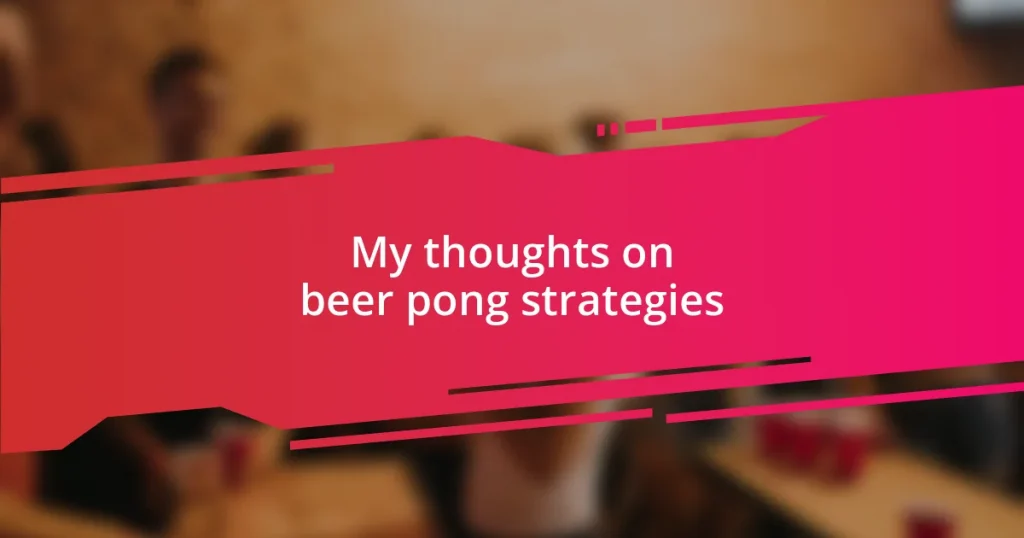Key takeaways:
- Mastering basic rules and cup positioning enhances team strategy and competitive spirit in beer pong.
- Utilizing techniques like distraction, teamwork, and consistent throwing improves overall gameplay and offensive success.
- Regular practice, self-reflection, and adaptability to opponents’ strategies are essential for skill enhancement and winning matches.

Understanding beer pong basics
Understanding the basics of beer pong starts with grasping its simple yet engaging rules. You’ll typically need two teams of two people, aiming to toss a ping pong ball into the opposing team’s cups, which are filled with beer or any preferred drink. Have you ever found yourself getting lost in the rhythm of a game, fueled by a mix of competitive spirit and a shout of encouragement from friends? It’s that contagious energy that makes every round feel electric.
The arrangement of the cups is crucial; they form a triangle on each side of the table, and the strategy behind their positioning can greatly influence your chances of winning. In my experience, keeping your cups structured and organized not only makes it harder for opponents to hit their target but also sets a focused tone for your team’s game. I recall a particularly memorable match where our careful positioning led us to a surprising victory against a seemingly unbeatable duo.
Moreover, understanding the underlying strategy will come in handy as the game progresses. The way you throw matters, and finding your style—whether it’s the high arc or direct shot—can make all the difference. What’s your go-to throw? I always prefer a gentle arc, which feels more relaxed and gives me a moment to aim. Finding that confident rhythm can transform a casual game into an unforgettable experience.

Key strategies for winning
When it comes to winning at beer pong, one of the most effective strategies I’ve learned is the art of distraction. Keeping your opponents off their game can be a game-changer. I remember a time when we deployed some humorous banter during a tense match, and it instantly shifted the focus away from their precision shots. They stumbled, both in concentration and accuracy. Never underestimate the power of laughter in a competitive setting!
Another strategy I find essential is teamwork and communication. Coordinate with your partner on angles, shot strength, and when to go for the win. I’ve found that signaling a “double shot” call, where both players take their turns in close succession, can catch the opposing team off-guard. In a recent game, this tactic led to a swift victory. Our opponents simply didn’t see it coming!
Lastly, developing a consistent throwing technique is crucial. I always recommend practicing different throws until one feels natural. For me, I’ve had success with a slight sidearm throw that works for a quick release. It’s important to be comfortable with your technique because a relaxed, confident throw often leads to better performance. They say practice makes perfect, but I believe it’s about finding what feels perfect for you!
| Strategy | Description |
|---|---|
| Distraction | Using humor and banter to shift focus and disrupt opponents’ concentration. |
| Teamwork | Effective communication with your partner can lead to surprise tactics and better shot coordination. |
| Consistent Technique | Practicing and mastering a throwing style that feels comfortable enhances overall performance. |

Offensive techniques to score
Offensive strategies in beer pong often revolve around creativity and confidence. Personally, I’ve found that varying shot angles can keep opponents guessing. For example, during one spirited match, I decided to switch things up by throwing the ball behind my back—much to everyone’s surprise. It not only broke the tension but also landed me a vital cup. That moment taught me that an unexpected move can shift the entire game’s momentum.
Here are some key offensive techniques to score:
- Fake Outs: Pretend to throw to catch your opponent off guard, then redirect your shot.
- Change of Pace: Throw at different speeds to disrupt your opponent’s timing.
- Target Focus: Always aim for the cup directly across from you to maintain control over the game.
- Team Synergy: Rotate shots between teammates strategically to prevent opponents from getting a clear read on your game plan.
In my experience, putting these offensive techniques into practice often leads to a more dynamic and exciting game. Each successful shot draws you closer as a team, boosting morale and enhancing the competitive spirit.

Defensive moves to consider
When considering defensive moves in beer pong, one key strategy I’ve found useful is to mentally psych out the opposing team. I remember a game where I purposely miscalculated my partner’s shots, looking overly dramatic about how many cups we had left. Not only did it confuse our opponents, but it also made them second-guess their plays. Have you ever noticed how doubt can creep in when you’re unsure about your opponent’s confidence?
Another effective defensive tactic is positioning yourself strategically around the table. By standing at an angle or altering your stance, I’ve noticed that it can disrupt an opponent’s line of sight and throw off their aim. For instance, during a heated match, I found that merely leaning a bit to the side created just enough distraction for my partner’s next shot to sneak in effortlessly. It’s fascinating how body language can reflect or influence the outcome of the game, don’t you think?
Additionally, keeping an eye on your opponent’s body language and habits is crucial. I once played against a team that always tilted their heads before making a shot. By noting such subtle patterns, I subtly called out a “distraction” right before they threw, which led to a crucial miss on their part. It’s incredible how being observant during a game can empower you—it’s almost like gaining a secret weapon that turns the tide in your favor!

Adjusting strategies for opponents
Adjusting strategies for opponents is key to gaining an edge in beer pong. I’ve learned that sizing up your opponent’s shooting style early on can shape your approach significantly. For instance, when I faced a team that favored high arcing shots, I adapted by suggesting that my partner take a more aggressive stance. Not only did this help balance the table, but it also set the expectation that we were prepared for anything.
In moments where the opposing team seems to dominate, I’ve found that changing our team’s rhythm can work wonders. I recall one instance where my partner and I sensed our rivals getting cocky after a few lucky shots. We switched into a slow-motion play, making each throw feel deliberate and thoughtful. Lowering the tempo threw them off their game. It’s fascinating how subtly shifting your energy can disrupt an opponent’s momentum, don’t you think?
Furthermore, I think it’s crucial to communicate openly with your teammate about the adjustments you notice. I once played alongside a friend who was fantastic at reading subtle details. When I pointed out our opponents were overcommitting to their left side, we systematically redirected our shots to capitalize on that weakness. It’s a beautiful dance of adaptability and awareness that keeps the game lively and engaging. How do you respond to changing dynamics during a match? It can be the difference between winning and losing!

Enhancing skills through practice
Practice is crucial if you want to enhance your beer pong skills. I remember a time when my friends and I decided to create a mini tournament, dedicating an entire weekend just to play. The hours we spent tossing balls back and forth significantly improved my aim and confidence. Have you ever felt that exhilarating buzz of watching your shots land successfully after putting in the time? It’s like a mini celebration each time you see a cup fall.
Repetition not only hones technical skills but also builds muscle memory. I often focused on a specific technique during my practice sessions—like throwing from different angles or varying my power. One week, I dedicated my evenings to mastering the straight shot and, believe me, the transformation was astounding! Each throw felt more natural, almost second nature. What’s your go-to practice drill that makes you feel unstoppable?
Moreover, analyzing your gameplay during practice can provide valuable insights. There were moments when I recorded our sessions and later reviewed them, noting areas for improvement. This self-reflection helped me understand not only my performance but also my teammates’. It was enlightening to see how slight tweaks could lead to major advancements. Isn’t it fascinating how practice becomes a learning tool, transforming frustrations into breakthroughs?















